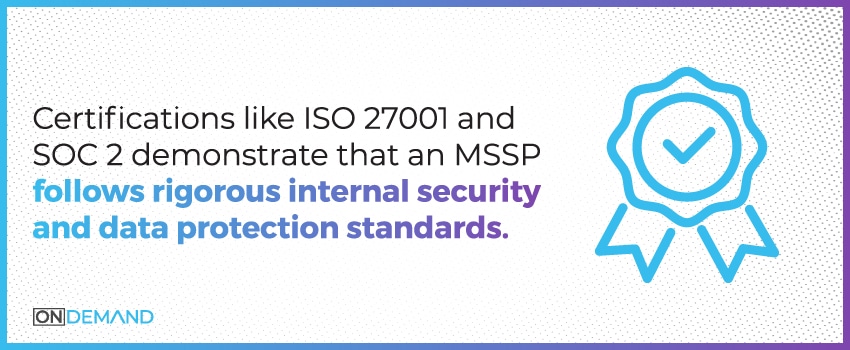Cyber attacks per organization increased by 47% in the first quarter of 2025,1 so choosing a cybersecurity partner has become one of the most important decisions for your business. The right provider can protect your valuable data, support compliance requirements, and respond when threats emerge – while the wrong choice might leave you vulnerable.
Whether you’re evaluating a traditional managed security service provider (MSSP) or a more specialized security provider, aligning with your organization’s unique needs and infrastructure is essential. Read on for the top best practices to keep in mind when choosing a cybersecurity partner.
Top 7 MSSP Best Practices
Ready to select a cybersecurity services provider? Here are seven best practices to help you find the right fit.
1. Understand Your Security Needs
Take time to assess your organization’s specific security requirements before starting your search. Consider your current threat landscape, existing security gaps, compliance requirements, and your team’s internal capabilities. Are you looking for full-service managed security services or just supplemental support in a few areas? Knowing this will help you narrow the field and find a provider with the right focus.

2. Ensure Your Provider Has Industry Expertise
Every industry faces unique risks and regulatory requirements. Look for providers with experience in your specific sector, especially if you’re in a regulated space like healthcare, finance, or retail. A provider that understands your compliance landscape will be better equipped to deliver solutions that keep you audit-ready and secure.
3. Look for Scalable Response Capabilities
Managed cybersecurity providers should offer around-the-clock coverage from a dedicated security operations center (SOC) – not just alerting but taking action when needed as well.
Your security solutions should also scale with your business growth, so choose a partner with flexible services designed to adapt to changing needs.
4. Leverage Advanced Tools and Threat Intelligence
The best cybersecurity partners don’t just detect threats; they anticipate and prevent them. Look for providers that leverage tools like AI and global threat intelligence to stay ahead of evolving risks. These capabilities enable faster detection, smarter response, and better overall protection.
5. Certifications and Security Standards Matter
Make sure your MSSP maintains certifications like ISO 27001, SOC 2, and others relevant to your industry. These credentials demonstrate that they follow rigorous internal security and data protection standards – something that’s just as important as the services they deliver to clients.

6. Prioritize Integration and Transparent SLAs
Cybersecurity tools work best when they’re aligned with your broader IT infrastructure. During your cybersecurity partner evaluation, ask if their services integrate with your existing EDR, SIEM, cloud platforms, and access controls.
You should also make sure to review service level agreements (SLAs) carefully. Look for transparent pricing and clearly defined responsibilities to avoid any surprises.
7. Choose a Partner That Feels Like Part of Your Team
The best MSSPs act as an extension of your team, not just a vendor. Choose a partner who prioritizes proactive communication, regular check-ins, and shared accountability. When issues arise, you want a provider who is already in sync with your goals and systems, not someone you have to bring up to speed.
Find a Managed Security Services Partner With Guidance From OnDemand
If you’re still not sure how to find the right security partner, you’re not alone. OnDemand simplifies cybersecurity provider selection with experienced, knowledgeable experts who sit on your side of the table and do what’s right for your business. We make vendor-agnostic recommendations based on our 15 years of vetting supplier partners, so you can rest easy knowing you have the right partner to keep your organization safe.
Contact us today to learn more about how we can help you evaluate providers and protect what matters most.
Sources:
